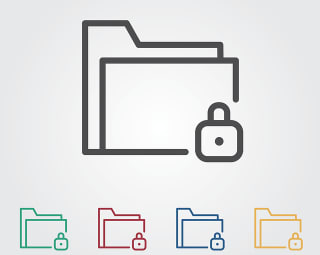Access control is a security measure which is put in place to regulate the individuals that can view, use, or have access to a restricted environment. Various access control examples can be found in the security systems in our doors, key locks, fences, biometric systems, motion detectors, badge system, and so forth.
Furthermore, creating or planning effective security measures using these access control systems start with understanding the principles involved. To better understand access control security, we need to break it down into its core elements, which include:
Identification: The primary aim of an access control system is protecting your building or a restricted area from unauthorized access. The access control system also controls the movement of individuals using the building. Hence, the access control system makes it possible for you to determine the identity of any person that enters the building, or accesses any of the secure or restricted areas within the building.
Authentication: Once the access control system identifies an individual, it is important that the person’s identity is authenticated. This will help ensure that only the right individuals are granted access into the building or area.
Authorization: After the system authenticates the individual’s identity successfully, building access control systems will be able to grant the person, access to the building or other secure or restricted areas, depending on the specified criteria.
What are the main aspects of access control? #
Every control plan example needs to integrate three aspects of business security: the technological, the administrative and the physical access control. Although each aspect has implications, functional physical access controls examples start from the ground, weaving the plan around the layout of the physical location.
When you are creating an access control plan, start by considering all aspects, and develop the actual document in sections. Certain businesses carry greater risk for internal threats, such as staff strikes or sabotage. Others are in disaster-prone areas, and require physical planning against natural and man-made disasters. A smaller company may rely on a single power source.The same option included in an access control plan for a corporation can create unforseen costs. That would have been easily avoided by following the lessons from other physical access controls examples created by large businesses.

Planning your physical security is all about who, when and how you’ll let into your premises. Thinking about the vulnerabilities of the access points will affect the type of doors, key locks, fences, camera systems, security guards, card or fob readers, biometric access, interdepartmental access and overall role distribution on horizontal and vertical level.
In a nutshell, the merit of an effective control plan example is in setting the right physical obstacles at critical points; to enable unrestricted work flow for authorized users and prevent unauthorized users from finding a way through.
What are the considerations for each abovementioned aspect of access control? #
Work on physical access control plans is concentrated on the physical protection of information, facilities, staff, visitors and contractors, technical installations, raw materials, products and other business resources. Physical access controls examples include prevention, deterrence and recovery. To enable sturdy and reliable physical security, consider including the following components as clear sections in the access control plan:
Physical Security #
Network identification and control. Doors, fences and locks need to be somehow controlled. What type of cabling is workable within your access control plan? Relate the relevant network with the authorized users, explain the clear distinctions in several control plan examples and ask your access control provider to help you choose the best.
Perimeter security and interdepartmental requirements. Will you use single authentication with card readers, or add security guards and on a CCTV system at the entry gate? Will your use motion sensors? How will you handle “out-of-the-blue” access? Is issuing cards or fobs always better than providing one-off mobile access codes? Define work areas with restricted access and identify the users with special authorizations for distinct departments.
Physical computer control. Define a central control, monitoring and reporting zone. Assign access to computer units on the ground and set access control tools. Is there a need fo a separate server room? (In most cases, the answer is yes.)
Technical Security #
User access. Define data sensitivity levels and assign appropriate user clearance levels. Use the space in your access control plan to define rules for setting passwords and specify technical aspects of wiring, routers, permissions and user access control.

Network encryptions and IT security protocols. Despite its user-friendliness, your plan needs to include methods for Certain access control plan examples tackle this in a comprehensive document; others restructure the information in appendices for trained IT staff.
Architecture. How will the logical and the physical layout of the IT network look like? How will you separate the access control between levels and areas?
Administrative Security #
Design a functional access control plan. The plan is an integral part of your business security. Make sure it includes guidelines for staff under various risk levels, incident response and recovery steps, procedures for maintenance, updates and audits of the access control system set in place.
Role-based security and supervision. This aspect need to reflect the distribution of authority within your company, state roles and link associated duties and responsibilities. Identify staff responsible for overseeing the plan, supervising the set controls and enabling training for staff and testing of the equipment.
How will an access control plan look like? #
No access control plan is alike. Each business facility must look at its particular circumstances.
Essential factors for each plan include steps for choosing the right technology, reviewing the building architecture and the spatial infrastructure around the facility, as well as considering other buildings’ proximity and the access control mechanisms already in place. The similarities between the majority of control plan examples are about describing the particular business requirements, assigning user responsibilities, defining access control software application, and setting rules for user management and monitoring.
If you need to adopt one from several proposed physical access controls examples, consider the business needs and the security aspects as described above. That’s one way to design the structure. If you want to dig into a more detailed version, examine this sample plan, and see what needs to go and what needs to stay in your example:
Introduction
- Security aspects
- Policies, guidelines and resources
- Access control model in use
Physical Security
- Security Staff
- Lighting, sensors and alarms
- Fences, door and locks
- CCTV and IP Cameras
- Access for law enforcement
Maintenance and Power Supply
- Energy sources
- Access control alternatives
- Spare parts and software updates
- System support and servicing
- Monitoring and reporting
Infrastructure
- Unit passwords
- Perimeter and internal access control
- Specialized equipment control
- Computer network control
- Role-based access control

